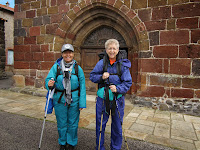 |
| Gray House |
 |
| Casserly House |
During my recent trip to Massachusetts, I had the
opportunity to visit two sites where sisters welcome the dear neighbor into
their home, truly divide the city and respond to the needs that present
themselves. Gray House in Springfield and Casserly House in Boston are homes that
were bought specifically for the purpose of living and ministering among
neighbors in economically stressed areas where there are great needs.
Gray House was purchased in 1982. This house damaged by fire was restored over
two years through the generous donations of labor and supplies. Opening in 1984, the unmet needs have determined
the services that are offered. English
as a second language is a big need for the local immigrant community. 35 volunteer tutors work with up to 100
students one on one and in small groups where they can get the individual
attention and encouragement that is often lacking in larger classroom
settings.
 |
| Deirdre in the food pantry |
Gray House also offers a food pantry and small used item
shop. Volunteers assist staff in providing these needed services, sorting
clothes, greeting clients, bagging food and many other tasks. Agrégée Deirdre Griffin
spoke about an annual gift that comes from a local Jewish temple which donates
100 pairs of new shoes every year for children in the neighborhood.
The after school program provides 15 youth in the 2nd
to 5th grade with homework assistance, relationship building skills,
structure and a family style dinner nightly.
The small number of children served allows for individual attention
which shows in the progress that the children make.
One staff person shared that the people who come to Gray
House are members of our community, not clients. This sense of being of the neighborhood
permeates everything they do.
Many of the programs at Casserly House are similar to those
at Gray House. In fact, they consulted
with the staff at Jubilee House (Hartford- Nov 19, 2011 blog) and Gray House as
they set up their home. In January 2006,
in response to a challenge the Boston CSJs set for themselves, they purchased
this home near the site of their first ministry in Boston. There was no preconceived notion of what
Casserly House would do. After living in
the neighborhood for six months and talking with the neighbors, they began
their first program.
 |
| A class on grocery shopping as a tool to practice English |
The first request came for help learning English. This is now a core part of their program with
neighbors coming by from 9 to noon, Monday through Friday to learn English. The
children said they needed help with their homework and so the After School
Program was developed where children receive help with homework, computer
training and art classes.
On the morning I visited, there was an unexpected school bus
strike. Anxious parents came to Casserly
House to try to understand what was happening and problem solve how to get
their children to and from school. When
there was an increase in domestic violence in the neighborhood, the neighbors
came together at Casserly with government officials to try to figure out what
could be done- and they came up with a workable plan. Police officers and city council members
often stop by Casserly House where they can learn from the people what their
needs and hopes for the neighborhood are.
 |
The program helped this woman with English,
citizenship and bringing her children to the US |
Again, while I was at Casserly House, a woman came in to
talk with Sr. Nancy. She shared that she
came to the US with no English. In her
country in West Africa, women were not educated so she could not read or write
in her native language. Over time, she
has learned to speak English very well, has become a citizen and been able to
bring three of her children to the United States. “I am so happy and grateful to Sr. Nancy,”
she shared. I asked her how she had
persevered through such challenging times.
She looked at Sr. Nancy and spoke about the program’s support making it
possible for her to have hope for her future and her families future.
For Sisters of St Joseph, our earliest documents and our
consensus statement remind us that our relationships with our neighbor are
fundamental to our reason for existing.
At these two houses, it is evident that our charism is alive and
healthy.



















































